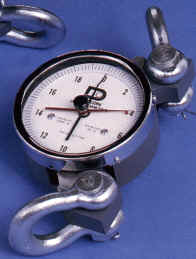
Product Information
Guy Wire/Turnbuckles/Grips
 The following average distributor pricing for EHS galvanized steel guy wire, preformed grips, cable clamps, thimbles, dead end sleeves and turnbuckles does not include taxes or freight. To allow for sag and tensioning, 5 to 10% should be added to your guy wire lengths. The following average distributor pricing for EHS galvanized steel guy wire, preformed grips, cable clamps, thimbles, dead end sleeves and turnbuckles does not include taxes or freight. To allow for sag and tensioning, 5 to 10% should be added to your guy wire lengths.
Use the guy wire calculation program to quickly identify the total length of guy wire that the project will require.
We recommend that you contact our valued distributors for your site-specific guy wire and attachment hardware requirements.
|
EHS GUY WIRE
|
|
Size
|
|
Weight
|
Breaking
|
*Initial
|
Price
|
|
|
Lbs./Ft.
|
Strength
|
Tension
|
Per Ft.
|
|
3/16"
|
1x7
|
0.08
|
5,000 lbs.
|
500 lbs.
|
$0.24
|
|
1/4"
|
1x7
|
0.117
|
6,650 lbs.
|
665 lbs.
|
$0.27
|
|
5/16"
|
1x7
|
0.171
|
11,200 lbs.
|
1,120 lbs.
|
$0.32
|
|
3/8"
|
1x7
|
0.22
|
15,400 lbs.
|
1,540 lbs.
|
$0.43
|
|
7/16"
|
1x7
|
0.399
|
20,800 lbs.
|
2,080 lbs.
|
$0.54
|
|
1/2"
|
1x7
|
0.517
|
26,400 lbs.
|
2,640 lbs.
|
$0.64
|
|
9/16"
|
1x7
|
0.67
|
35,000 lbs.
|
3,500 lbs.
|
$0.85
|
|
5/8"
|
1x19
|
0.813
|
42,400 lbs.
|
4,240 lbs.
|
$1.03
|
|
3/4"
|
1x19
|
1.155
|
58,300 lbs.
|
5,830 lbs.
|
$1.82
|
|
7/8"
|
1x19
|
1.581
|
79,700 lbs.
|
7,970 lbs.
|
$2.40
|
|
1"
|
1x19
|
2.073
|
104,500 lbs.
|
10,450 lbs.
|
$4.87
|
|
*Typical pretensioning is 10% of the breaking strength. Check construction drawings for site specific initial tension requirements. Additional information can be found in EIA/TIA 222F.
|
Preform Grips - Cable Clamps - Thimbles - Dead End Sleeves
|
Size
|
Preformed Grips
|
Cable Clamps
|
Thimbles
|
Dead End Sleeves
|
|
3/16"
|
$4.15
|
$2.50
|
$1.70
|
$1.70
|
|
1/4"
|
$5.00
|
$3.10
|
$1.85
|
$1.85
|
|
5/16"
|
$7.60
|
$3.45
|
$1.95
|
$2.00
|
|
3/8"
|
$12.60
|
$3.90
|
$2.20
|
$2.80
|
|
7/16"
|
$13.65
|
$4.65
|
$2.50
|
$3.10
|
|
1/2"
|
$18.75
|
$5.50
|
$3.00
|
$3.40
|
|
9/16"
|
$26.25
|
$6.45
|
$3.45
|
$3.80
|
|
5/8"
|
$46.00
|
$7.65
|
$3.95
|
$4.75
|
|
3/4"
|
$75.00
|
$8.80
|
$5.40
|
$5.40
|
|
7/8"
|
$135.00
|
$9.95
|
$7.00
|
$6.40
|
|
1"
|
$240.00
|
$12.75
|
$9.75
|
$8.30
|
Turnbuckles - Jaw-Jaw
|
Size
|
Turnbuckle
|
WorkingLoad
|
Wt./lb.
|
Price
|
|
1/4"x4"
|
Jaw-Jaw
|
500 lbs.
|
0.50
|
$18.50
|
|
1/2"x12"
|
Jaw-Jaw
|
2,200 lbs.
|
2.40
|
$32.00
|
|
5/8"x12"
|
Jaw-Jaw
|
3,500 lbs.
|
4.00
|
$52.00
|
|
3/4"x12"
|
Jaw-Jaw
|
5,200 lbs.
|
6.50
|
$72.00
|
|
7/8"x12"
|
Jaw-Jaw
|
7,200 lbs.
|
10.00
|
$95.00
|
|
1"x 12"
|
Jaw-Jaw
|
10,000 lbs.
|
14.00
|
$122.00
|
|
1 1/4"x12"
|
Jaw-Jaw
|
15,200 lbs.
|
25.00
|
$230.00
|
|
1 1/2"x12"
|
Jaw-Jaw
|
21,400 lbs.
|
38.00
|
$325.00
|
Turnbuckles - Jaw-Eye
|
Size
|
Turnbuckle
|
WorkingLoad
|
Wt./lb.
|
Price
|
|
1/4"x4"
|
Jaw-Eye
|
500 lbs.
|
0.50
|
$15.75
|
|
1/2"x12"
|
Jaw-Eye
|
2,200 lbs.
|
2.40
|
$22.25
|
|
5/8"x12"
|
Jaw-Eye
|
3,500 lbs.
|
4.00
|
$44.50
|
|
3/4"x12"
|
Jaw-Eye
|
5,200 lbs.
|
6.50
|
$70.00
|
|
7/8"x12"
|
Jaw-Eye
|
7,200 lbs.
|
10.00
|
$85.75
|
|
1"x 12"
|
Jaw-Eye
|
10,000 lbs.
|
14.00
|
$118.00
|
|
1 1/4"x12"
|
Jaw-Eye
|
15,200 lbs.
|
25.00
|
$178.00
|
|
1 1/2"x12"
|
Jaw-Eye
|
21,400 lbs.
|
38.00
|
$232.00
|
Aligning yourself with the right tensioning tools
The installed tension for guy wire is typically 10% of the wire’s breaking strength. Initial tension may be mesured by vibration frequency, mechanical tensionmeters, measurement of guy sag, or by other suitable methods. Direct and indirect are the two common methods of measuring guy tension on towers. The direct method uses mechanical or hydraulic equipment to pull the guy wire to measure the tension with a calibrated gauge. A mechanical dynamometer capable of measuring up to 20,000 lbs. runs approximately $900.00 list. The indirect method uses assumptions and calculations to predict the tension. The most common application of this method is the Sag Intercept method. Another tool measures the harmonic frequency of the guy wires and runs $2,900.00 list for measuring the tension of wires up to 3/4”.
Cycling method sometimes used
Although not as reliable as other methods, an oscillation technique can be used to identify the approximate tension when all of your testing equipment is on another job site.
Grasp the guy wire in front of the anchor and start a horizontal pendulum-like motion by pushing from side to side. When the guy is swinging slightly and easily in a side-to-side single arc, begin to count as it hits your raised index finger. Push lightly on the guy to maintain the motion while counting. The below chart will indicate how many cycles per minute there should be for the accompanying guy wire length of all sizes.
Ambient temperature affects tower guy tensions and must be considered when adjustments are made. There should be relatively little wind when taking the measurements. Check construction drawings for site-specific initial tension requirements.
Guy Wire Cycling Chart For
Approximate Tension
| Guy Wire Length |
Cycles Per Minute |
Guy Wire Length |
Cycles Per Minute |
Guy Wire Length |
Cycles Per Minute |
| 75 |
151 |
146 |
77 |
248 |
46 |
| 76 |
149 |
153 |
74 |
252 |
45 |
| 78 |
154 |
156 |
72 |
256 |
44 |
| 81 |
140 |
167 |
68 |
264 |
43 |
| 85 |
133 |
170 |
67 |
269 |
42 |
| 87 |
130 |
181 |
63 |
278 |
41 |
| 89 |
127 |
184 |
62 |
283 |
40 |
| 91 |
123 |
185 |
61 |
292 |
39 |
| 94 |
120 |
188 |
60 |
297 |
38 |
| 99 |
114 |
198 |
57 |
306 |
37 |
| 100 |
113 |
200 |
57 |
311 |
36 |
| 113 |
100 |
208 |
54 |
320 |
35 |
| 114 |
99 |
213 |
53 |
325 |
35 |
| 117 |
97 |
217 |
52 |
334 |
34 |
| 121 |
93 |
223 |
51 |
340 |
33 |
| 127 |
89 |
226 |
50 |
348 |
32 |
| 131 |
86 |
231 |
49 |
362 |
31 |
| 136 |
83 |
236 |
48 |
376 |
30 |
| 144 |
79 |
240 |
47 |
|
|
The direct method using a dynometer
A dynomometer with a length adjustment device, such as a come-along, is attached to the guy system by clamping onto the guy just above the turnbuckle and onto the anchor shaft below the turnbuckle. above the turnbuckle and onto the anchor shaft below the turnbuckle.
The come-along is then tightened until the original turnbuckle begins to slacken, allowing the dynometer to carry the guy load to the anchor. The guy tension is then read off the dynometer dial.
By adjusting the come-along the proper installation tension will be attained when registered on the dynamometer.
Two registration points are then marked, one above the clamping point on the guy wire and one on the anchor shaft, and the control length is measured. The dynamometer and come-along are then removed, and the turnbuckle is adjusted to maintain the registration points measured.
|